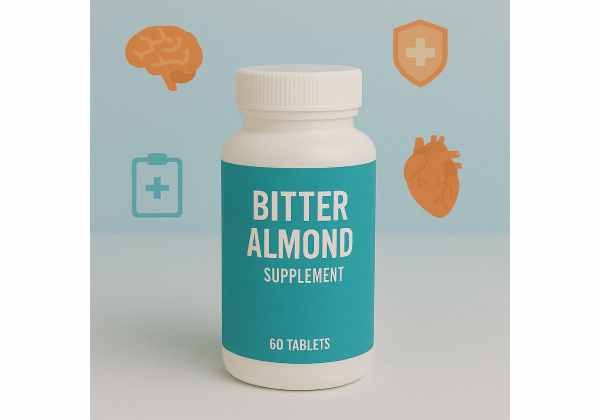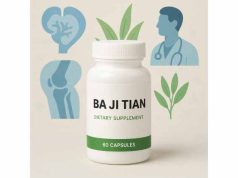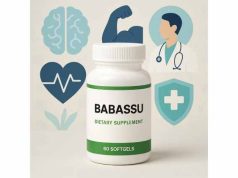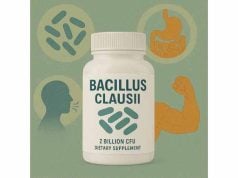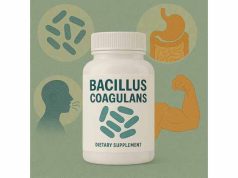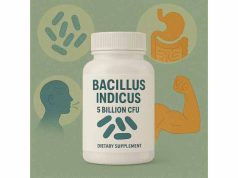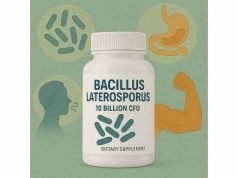Bitter almond, the seed of the Prunus amygdalus var. amara tree, has a long and complex history in natural medicine and culinary traditions. Unlike the sweet almonds commonly eaten as snacks, bitter almonds contain potent plant compounds that have been valued for their aromatic oils, digestive support, and traditional health uses. However, these seeds also harbor natural toxins that demand careful preparation and mindful use. Today, bitter almond extract appears in supplements, cosmetics, and as a flavoring, while ongoing research explores its antioxidant, antimicrobial, and potential anti-cancer properties. This in-depth guide examines the science, benefits, proper usage, and critical safety concerns surrounding bitter almond supplements and products.
Key Takeaways
- Bitter almond is distinct from sweet almond and contains amygdalin, which can convert to toxic cyanide if not properly processed.
- Common uses include aromatherapy oils, traditional digestive aids, and topical skincare—never as raw, whole nuts.
- Modern research explores antioxidant, antimicrobial, and possible anti-tumor actions, but ingestion safety is a major concern.
- All edible and supplemental forms must be professionally processed to remove or reduce toxins.
- Consult a healthcare provider before using bitter almond in any form, especially if pregnant, nursing, or taking medications.
Table of Contents
- Bitter Almond Botanical Overview: Tradition and Modern Uses
- Bitter Almond Bioactive Compounds and How They Affect the Body
- Evidence-Based Benefits and Traditional Applications of Bitter Almond
- Bitter Almond Supplement Safety, Toxicity, and Drug Interactions
- Safe Dosage, Recommended Forms, and Guidelines for Bitter Almond Use
- Bitter Almond FAQ: Frequently Asked Questions Answered
Bitter Almond Botanical Overview: Tradition and Modern Uses
Bitter almond comes from a wild or cultivated variety of almond tree native to the Middle East, South Asia, and the Mediterranean. While it looks nearly identical to sweet almond, bitter almond’s seeds contain higher levels of the natural chemical amygdalin, making them much less suitable—and often unsafe—for direct consumption.
Key Features of Bitter Almond:
- Botanical name: Prunus amygdalus var. amara (or Prunus dulcis var. amara)
- Appearance: Similar in size, shape, and shell to sweet almond, but typically more bitter in taste due to specific plant compounds.
- Traditional uses: Used historically for digestive issues, as a flavoring agent, in skin and hair care, and in herbal medicine preparations.
Historical and Regional Applications:
- Europe and Middle East: Bitter almond oil was long used as a digestive tonic and cough remedy in folk medicine, but only in small, processed amounts.
- Asia: In Traditional Chinese Medicine, bitter almond (known as “xing ren”) is used for respiratory complaints and as a mild laxative—again, only after proper detoxification.
- Culinary uses: Bitter almond essence and marzipan flavorings are made with purified, processed oils to impart a characteristic aroma to sweets, pastries, and liqueurs.
Modern Applications:
- Essential oil and extracts: Used in aromatherapy, cosmetics, soaps, and massage oils for their scent and purported skin-softening effects.
- Supplements: Bitter almond extract, after detoxification, is sometimes marketed for its antioxidant and antimicrobial potential, usually as a liquid or capsule.
- Cosmetics: Bitter almond oil is prized in skincare for moisturizing, softening, and anti-aging benefits—especially when blended with sweet almond or carrier oils.
What Sets Bitter Almond Apart?
- Its amygdalin content, which can release hydrogen cyanide, gives it medicinal value but also significant toxicity concerns.
- All medicinal and culinary uses of bitter almond in the U.S. and Europe require processing to ensure safety.
Who Uses Bitter Almond—and Why?
- Individuals interested in traditional or holistic wellness
- People seeking natural alternatives for skin or scalp care
- Aromatherapists looking for a classic almond fragrance
- Those exploring plant-based digestive aids (always in processed, regulated forms)
Summary:
Bitter almond is a unique and potent botanical, celebrated for its aroma and traditional health uses, yet only safe when properly prepared. Its modern forms focus on topical and extract-based applications, never raw seeds.
Bitter Almond Bioactive Compounds and How They Affect the Body
The powerful actions—and risks—of bitter almond stem from its distinct chemistry. Unlike sweet almond, bitter almond’s therapeutic and toxic effects are driven by a single compound: amygdalin.
Key Active Compounds:
- Amygdalin: A cyanogenic glycoside, amygdalin breaks down in the digestive system to release hydrogen cyanide—a potent toxin. While it’s been explored for various medicinal uses, its presence is the primary reason bitter almond is strictly regulated.
- Essential fatty acids: Like sweet almond, bitter almond oil is rich in monounsaturated and polyunsaturated fats, contributing to its emollient properties.
- Vitamin E and antioxidants: Bitter almond oil contains vitamin E and phenolic compounds that may help protect cells from oxidative damage when used topically.
- Other phytochemicals: Flavonoids and saponins, contributing to the seed’s traditional reputation for soothing and antimicrobial effects.
How Do These Compounds Affect Health?
- Amygdalin and cyanide release: Raw bitter almonds, when chewed or digested, can release potentially dangerous levels of cyanide. This is why unprocessed bitter almonds are banned in many countries as a food product. Proper processing (e.g., heating, specific extraction) removes or neutralizes most of the cyanide, making extracts or oils safe for external or occasional internal use under supervision.
- Antioxidant and antimicrobial activity: Purified bitter almond extract shows antioxidant and mild antimicrobial effects in laboratory studies, supporting its use in topical skin care and traditional remedies.
- Digestive support (historical): Folk medicine used small, detoxified amounts of bitter almond for upset stomach, but this is no longer recommended due to toxicity risk.
Topical vs. Internal Use:
- Topical: Bitter almond oil, properly processed, is considered safe for most adults as a skin moisturizer or massage oil, delivering antioxidants and hydration.
- Internal (oral): Only highly purified, professionally detoxified extracts should ever be ingested, and only under medical supervision due to the risk of cyanide poisoning.
Summary:
Bitter almond’s unique properties and dangers come from amygdalin, making it essential that only processed forms are used—especially for supplements or ingestion.
Evidence-Based Benefits and Traditional Applications of Bitter Almond
Despite the justified safety concerns, bitter almond’s traditional uses and modern research offer insight into its health potential—especially in its purified, professionally processed forms.
Traditional Health Benefits and Applications:
- Digestive aid: In European and Middle Eastern herbalism, processed bitter almond was used for flatulence, indigestion, and as a carminative (relieves gas).
- Cough and respiratory relief: In Traditional Chinese Medicine, “xing ren” is prescribed to calm coughs and clear mucus, though always in precisely dosed, detoxified preparations.
- Laxative action: Small doses were historically used as a mild laxative for occasional constipation.
- Flavoring and aroma: Even in tiny quantities, bitter almond extract adds a characteristic almond scent and flavor to pastries, liqueurs, and marzipan.
Modern Research and Potential Benefits:
- Antioxidant properties: Bitter almond oil and extract demonstrate the ability to neutralize free radicals in lab studies, which may benefit skin and reduce signs of aging.
- Antimicrobial action: Laboratory research shows bitter almond extract can help fight bacteria and fungi, supporting its traditional use in oral and skin care.
- Anti-inflammatory effects: Topical application of bitter almond oil may reduce skin irritation, itching, or redness.
- Potential anticancer research: Amygdalin (sometimes marketed as “laetrile” or “vitamin B17”) has been controversially promoted as an anti-cancer agent. However, major health organizations do not recommend its use due to lack of evidence and high risk of cyanide toxicity.
Cosmetic and Skincare Benefits:
- Moisturizing and softening: Bitter almond oil hydrates and improves the texture of skin and hair, often included in lotions, creams, and shampoos.
- Soothing effect: Its emollient properties can help reduce dryness and irritation, especially in sensitive or aging skin.
Summary:
Bitter almond’s most reliable benefits are seen in topical skincare, aroma, and traditional digestive support—but only when processed for safety. Claims about anti-cancer or internal health effects should be viewed with skepticism and caution.
Bitter Almond Supplement Safety, Toxicity, and Drug Interactions
Safety is the single most important concern with bitter almond, due to its natural content of amygdalin—a compound that releases cyanide in the body. Understanding how to use bitter almond safely, what side effects to watch for, and which interactions to avoid is essential for anyone considering this supplement.
Understanding Bitter Almond Toxicity
- Cyanide risk: Amygdalin is converted to hydrogen cyanide during digestion. Even small amounts of raw bitter almonds can cause symptoms of cyanide poisoning, including headache, confusion, rapid breathing, dizziness, nausea, and in severe cases, seizures, coma, or death.
- Legal restrictions: Most countries ban the sale of raw bitter almonds for consumption. Only processed, detoxified bitter almond products—where amygdalin is neutralized—are allowed for use in supplements, flavorings, or oils.
- Children and sensitive groups: Children are especially susceptible to cyanide poisoning. Never give bitter almond or related products to children unless they are certified as toxin-free and prescribed by a healthcare provider.
Side Effects of Bitter Almond (Even in Processed Form)
- Digestive upset: Nausea, vomiting, or stomach pain may occur, especially if products are not fully detoxified.
- Allergic reactions: Like other nuts, bitter almond can trigger allergic symptoms, including hives, swelling, or breathing difficulties.
- Skin irritation: Essential oils or undiluted extracts may cause irritation, redness, or rash if applied directly to sensitive skin.
Drug Interactions to Consider
- Respiratory medications: Because cyanide poisoning depresses respiration, bitter almond should never be used alongside medications that affect breathing or sedatives.
- Blood pressure drugs: There is a theoretical risk of additive effects, especially with products containing high concentrations of bitter almond oil.
- Enzyme-inhibiting drugs: Some drugs that slow liver enzyme activity could alter how the body processes amygdalin, potentially raising cyanide risk.
- Other supplements: Avoid using bitter almond with other supplements known for strong cardiovascular, respiratory, or sedative effects.
Who Should Avoid Bitter Almond Entirely?
- Pregnant or breastfeeding women (risk of toxicity to both mother and child)
- Individuals with liver or kidney disease (reduced ability to detoxify cyanide)
- People with nut allergies
- Children and infants
- Anyone taking medications that interact with liver enzymes or respiratory function
Signs of Bitter Almond Overdose or Poisoning
- Bitter or metallic taste in mouth
- Nausea, vomiting, or abdominal pain
- Dizziness, weakness, or rapid heart rate
- Shortness of breath or difficulty breathing
- Seizures, loss of consciousness
Emergency Response
If you suspect bitter almond poisoning or experience any of these symptoms after ingestion, seek medical help immediately. Do not attempt to treat at home.
How to Use Bitter Almond Safely
- Only use detoxified, professionally prepared extracts or oils from reputable brands.
- Never eat raw or homemade bitter almonds, even in small quantities.
- Follow all dosage guidelines closely. More is never better.
- Perform a patch test before using topical bitter almond oil, especially if you have sensitive skin or allergies.
- Consult your healthcare provider before starting any bitter almond supplement, particularly if you have health conditions or take medications.
Summary:
Bitter almond should always be treated with caution and respect for its potent toxicity. Safe use is only possible with professionally processed extracts and strict adherence to dosing and safety protocols.
Safe Dosage, Recommended Forms, and Guidelines for Bitter Almond Use
Because of the risks associated with raw bitter almonds, all health and culinary uses must rely on detoxified, regulated extracts or oils. Here’s how to approach bitter almond supplements and topical products with safety and effectiveness in mind.
Approved Forms of Bitter Almond
- Bitter almond oil (external use): The most common, safe, and regulated form. Used in skincare, massage, aromatherapy, and as a fragrance in foods (once amygdalin is removed).
- Bitter almond extract (internal use): Available as a food-grade flavoring or in highly purified supplement form. Only use products labeled as “free from hydrocyanic acid” or “HCN-free.”
- Capsules/tablets: Some supplements contain detoxified bitter almond extract, typically at doses well below toxic thresholds and with strict manufacturing controls.
Recommended Dosages
- Topical oil: Use a few drops (usually 2–5) diluted in a carrier oil for massage or direct skin application. Always do a patch test first.
- Oral extract (flavoring): Generally, just a drop or two per serving in baked goods or confectionery, ensuring the product is certified food-safe and HCN-free.
- Supplements: Follow manufacturer instructions exactly. Typical detoxified extract doses are 100–300 mg per capsule, once daily or as directed by a health professional.
Best Practices for Use
- Never exceed the recommended dose. More can be dangerous or even deadly.
- Use only products from reputable brands with clear detoxification and safety documentation.
- Avoid self-prepared or imported raw bitter almond products. These are often unregulated and unsafe.
- If you have nut allergies, avoid all almond-derived products.
- Store all supplements and oils safely away from children and pets.
Timing and Duration
- Short-term use is safest. Most experts recommend using bitter almond topically or as a flavoring for no more than a few weeks at a time, unless otherwise instructed.
- Long-term internal use is not recommended due to possible cumulative toxicity.
Signs You Should Discontinue Use
- Skin irritation, itching, or rash (topical use)
- Any digestive symptoms or “odd” sensations (oral use)
- Any symptoms of cyanide poisoning (immediate medical help required)
Summary:
Bitter almond can be used safely in professionally detoxified extracts, topical oils, and food-grade flavorings, provided you adhere strictly to dosing guidelines and avoid raw, unprocessed forms.
Bitter Almond FAQ: Frequently Asked Questions Answered
Is bitter almond safe to eat or take as a supplement?
No, raw bitter almonds are not safe to eat. Only professionally detoxified extracts or oils should be used, and always under strict dosage guidelines to prevent cyanide poisoning.
What are the main uses of bitter almond?
Bitter almond is most often used in its detoxified oil or extract form for skin care, aromatherapy, as a flavoring, and in traditional remedies. Internal use is strictly limited to regulated, processed products.
Can bitter almond help with cancer or serious diseases?
Despite claims, there is no reliable clinical evidence that bitter almond (or its compound amygdalin/laetrile) treats or prevents cancer. Using unregulated or raw forms for this purpose is extremely dangerous.
Are there any safe alternatives to bitter almond for health or flavor?
Yes. Sweet almond oil provides similar skin benefits without toxicity risks, and almond flavorings made from apricot kernels or synthetics are widely available and safe.
What side effects should I watch for with bitter almond use?
Look for digestive upset, headache, dizziness, or allergic reactions. Any sign of cyanide poisoning (confusion, weakness, difficulty breathing) is an emergency.
Can children or pregnant women use bitter almond?
No. Due to the risk of toxicity, bitter almond is not safe for children, pregnant women, or breastfeeding mothers.
How can I tell if a product is safe to use?
Only purchase bitter almond products from reputable brands that provide clear information about detoxification, safety, and dosage. Avoid raw or imported products without safety certification.
Disclaimer:
The information provided in this article is for educational purposes only and should not be considered a substitute for professional medical advice, diagnosis, or treatment. Always consult your healthcare provider before using any new supplement, especially if you have health conditions, take medications, or are pregnant or breastfeeding.
If this guide on bitter almond was helpful, please consider sharing it on Facebook, X (formerly Twitter), or your favorite social platform. Your support allows us to keep bringing you reliable, science-based natural health content. Follow us for more evidence-backed wellness guides!


